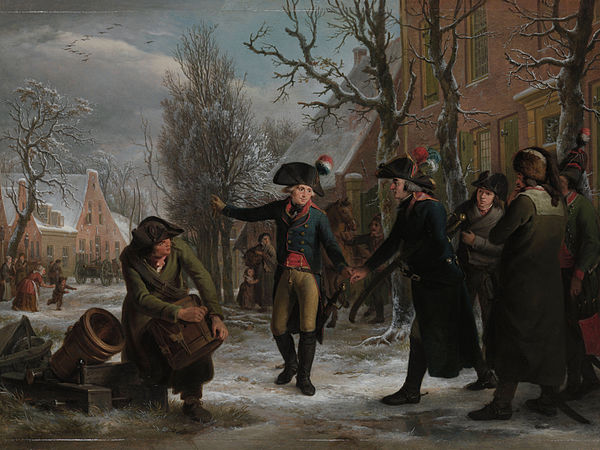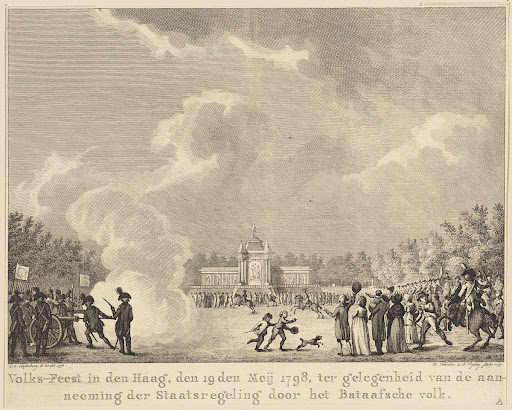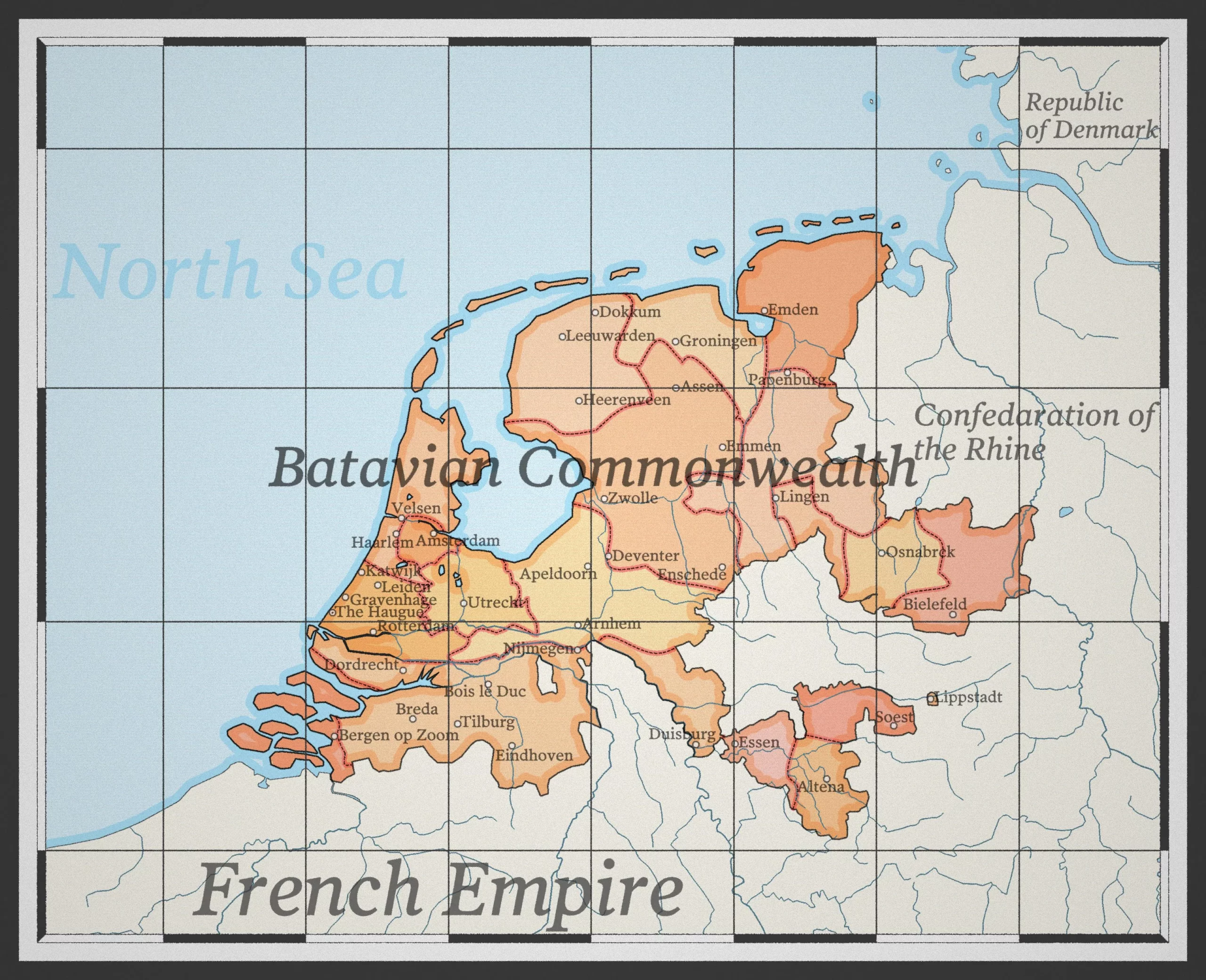The Batavian Republic, known in Dutch as the “Bataafse Republiek” and in French as the “République Batave,” was a political entity that succeeded the Republic of the Seven United Netherlands.
It existed on January 19, 1795, and marked a transformative period in Dutch history.
Introduction to The Batavian Republic
The Batavian Republic was a short-lived political entity that existed in the late 18th century, from 1795 to 1806, in what is now the Netherlands.
It emerged as a result of the French Revolution and the expansionist policies of the French Republic under Napoleon Bonaparte. The name “Batavian” was inspired by the historical Batavi, a Germanic tribe that once inhabited the region.
In 1794, French revolutionary forces invaded the Dutch Republic, which was experiencing internal strife and economic difficulties.
The invasion led to the establishment of the Batavian Republic in 1795, marking the end of the Dutch Republic and the beginning of a new era.
Historical Background

Transition from the Republic of the Seven United Netherlands
The transition from the Republic of the Seven United Netherlands to the Batavian Republic was a complex process marked by internal strife, external threats, and economic difficulties.
The Dutch Republic, established in the late 16th century, was a federal state composed of semi-autonomous provinces.
However, by the late 18th century, the republic faced decline due to economic stagnation, political corruption, and external pressures.
Economic Decline: The Dutch Republic had once been a major economic and naval power, but by the 18th century, it faced economic decline. The loss of colonial possessions and competition with other European powers contributed to economic challenges, impacting trade and prosperity.
Internal Strife: Groups with different political views in the Dutch Republic, like the Orangists who backed the House of Orange, and the Patriots, who wanted democratic changes, caused conflicts within the country.
This internal strife weakened the republic’s ability to respond effectively to external threats.
French influence and the role of General Charles Pichegru
French Revolutionary Wars: The French Revolutionary Wars, which began in 1792, profoundly impacted Europe. The French revolutionary government, aiming to spread revolutionary ideals, sought to expand its influence beyond its borders.
The Dutch Republic became a target as both a strategic location and due to its internal divisions.
Invasion by French Forces: In 1794, French revolutionary forces, led by General Charles Pichegru, invaded the Dutch Republic.
Pichegru’s military victories, combined with backing from Dutch Patriots who wanted democratic changes, made it easier for the French to take control of important Dutch cities.
Orangist Opposition: Despite internal support for the French invasion, Orangists opposed the revolutionary changes.
The House of Orange, traditionally associated with the Stadtholderate, faced increasing opposition from democratic forces aligned with the French.
Pichegru’s Role: General Charles Pichegru played a crucial role in the success of the French forces. His military strategies and alliances with Dutch Patriot factions contributed to the collapse of the existing political order in the Dutch Republic.
Proclamation of the Batavian Republic in 1795
The collapse of the Dutch Republic: By 1795, the Dutch Republic was in disarray. Internal conflicts, French military intervention, and the decline of the traditional political structure paved the way for a new political entity.
Proclamation of the Batavian Republic: On January 19, 1795, the Batavian Republic was officially proclaimed. This marked the end of the Dutch Republic and the beginning of a new era under French influence.
The Batavian Republic was initially established as a democratic and revolutionary state, with hopes of embodying the principles of the French Revolution.
French Control: Despite its initial aspirations for independence, the Batavian Republic soon found itself increasingly under French control. The French sought to use the republic as a satellite state to advance their political and military objectives in Europe.
The transition from the Dutch Republic to the Batavian Republic reflected the broader political and military dynamics of the time, shaped by the French Revolutionary Wars and the influence of revolutionary ideals on the European continent.
Political and Social Reforms
The adoption of a new constitution in 1798
Constitutional Changes: The Batavian Republic underwent significant constitutional changes with the adoption of a new constitution in 1798.
The constitution replaced the existing political structure inherited from the Dutch Republic and aimed to reflect the democratic principles of the French Revolution.
Key Provisions: The constitution of 1798 introduced several key provisions, including universal suffrage for male citizens, the establishment of a National Assembly, and a more centralized form of government.
The political landscape shifted from the decentralized federal structure of the Dutch Republic to a unitary state.
Political Reorganization: The new constitution reorganized the political system, reducing the power of local authorities and vesting more authority in a central government. This centralization aimed to create a more cohesive and efficient governance structure.
Democratic principles and centralized government
Universal Suffrage: The inclusion of universal suffrage in the constitution was a notable democratic principle adopted by the Batavian Republic. While limited to male citizens, this marked a departure from the more restrictive voting practices of the Dutch Republic.
National Assembly: The establishment of a National Assembly served as a key democratic institution. Elected representatives from various regions of the Batavian Republic convened to legislate and make decisions on behalf of the nation.
This shift toward representative democracy aimed to involve citizens in the political process.
Centralized Government: The French model influenced the move towards a more centralized government. The Batavian Republic sought to streamline governance and decision-making processes, consolidating power at the national level.
This centralization was intended to enhance the republic’s ability to implement reforms and respond to external challenges.
Reforms influenced by French revolutionary ideals
Economic Reforms: The Batavian Republic implemented economic reforms influenced by French revolutionary ideals. These reforms aimed at modernizing the economy and promoting equality.
Efforts included the creation of a national bank, the adoption of the metric system, and initiatives to improve agriculture and industry.
Legal Reforms: Legal reforms were introduced to create a more egalitarian and just legal system. The influence of French revolutionary ideals can be seen in changes such as abolishing feudal privileges, equal taxation, and establishing legal equality among citizens.
Education and Culture: The Batavian Republic also sought to promote education and culture, aligning with the revolutionary emphasis on enlightenment.
Changes were made in education to make it easier for people to learn, and efforts were made to help cultural institutions promote a strong national identity and unity.
Secularization: The influence of French revolutionary principles led to a degree of secularization in the Batavian Republic. Efforts were made to reduce the influence of religious institutions in governance, reflecting the secular ideals of the French Revolution.
While the Batavian Republic’s adoption of democratic principles and reforms aligned with the ideals of the French Revolution, the republic faced internal dissent and external pressures.
Ultimately, the political landscape evolved further with the establishing of the Kingdom of Holland under French influence in 1806.
Internal Challenges and Conflicts
The emergence of political factions (federalists vs. unitarist)
Political Fragmentation: The emergence of political factions within the Batavian Republic highlighted internal divisions. Two prominent factions were the Federalists and the Unitarians, reflecting differing views on the organization and governance of the young republic.
Federalists: Federalists advocated for a more decentralized political structure, echoing the historical Dutch preference for provincial autonomy. They were concerned about the concentration of power at the national level and sought to preserve regional authority.
Unitarists: Unitarists, on the other hand, supported a strong central government. Influenced by French revolutionary ideals, they sought to maintain the unitary state structure introduced in the new constitution of 1798.
Unitarians believed that a more centralized government was essential for effective governance.
Struggles within the Batavian Republic
Power Struggles: The internal political struggles within the Batavian Republic led to power conflicts between the federalists and unitarists. These struggles often manifested in debates within the National Assembly, with each faction vying for influence over the direction of the republic.
French Influence: The continued influence of France added another layer of complexity to internal conflicts. As a satellite state of France, the Batavian Republic faced pressure to align its policies with French interests.
This created tensions within the republic, with some factions resisting perceived French interference.
Economic Challenges: Economic difficulties persisted, contributing to internal strife. The attempts at economic reforms faced resistance from various quarters, and the republic struggled to address the economic issues inherited from the Dutch Republic.
Impact on the stability of the young republic
Political Instability: The internal conflicts and power struggles significantly undermined the stability of the Batavian Republic. The constant debates over the form of government and the influence of external powers created an environment of political uncertainty.
Short-lived Reforms: While the Batavian Republic aimed to implement democratic and revolutionary reforms, internal conflicts often hindered the effective implementation of these measures.
The republic’s reforms were relatively short-lived, and the political situation remained in flux.
Role in French Expansion: The Batavian Republic’s status as a satellite state aligned with French interests made it a pawn in the broader European conflicts of the time.
As France expanded its influence, the republic’s internal challenges became entwined with larger geopolitical dynamics.
Transition to the Kingdom of Holland: The internal struggles and challenges eventually contributed to the downfall of the Batavian Republic. In 1806, Napoleon Bonaparte abolished the republic and established the Kingdom of Holland under his brother Louis Bonaparte.
This marked the end of the Batavian Republic and the beginning of a new phase in Dutch history.
In summary, internal challenges, including factionalism, struggles over governance, and economic difficulties, played a crucial role in shaping the turbulent and relatively short existence of the Batavian Republic.
The republic’s internal conflicts and external pressures ultimately influenced its transition to the Kingdom of Holland under French control.
The End of the Batavian Republic
Louis Bonaparte’s accession to the Dutch throne in 1806
Napoleonic Influence: Louis Bonaparte, the younger brother of Napoleon Bonaparte, was appointed as the monarch of the Batavian Republic in 1806. This move was part of Napoleon’s broader strategy to consolidate control over European territories and ensure the loyalty of satellite states.
Abolition of the Batavian Republic: With Louis Bonaparte’s accession to the Dutch throne, the Batavian Republic was officially abolished. The transformation marked the end of the republic’s experiment with democratic and revolutionary ideals, as it gave way to a more traditional monarchical form of governance.
Transformation into the Kingdom of Holland
Creation of the Kingdom: Louis Bonaparte ruled as King of Holland, transforming the former Batavian Republic into the Kingdom of Holland.
Despite the change in political structure, the kingdom remained under French influence, and Louis ruled as a puppet monarch, implementing policies in line with Napoleon’s directives.
Continuation of Reforms: While the Kingdom of Holland retained some of the reforms introduced during the Batavian Republic, such as the legal and economic changes, Louis Bonaparte faced challenges in balancing the interests of his Dutch subjects with the demands of his brother, Napoleon.
Strained Relations: Louis Bonaparte’s attempts to govern independently and protect Dutch interests led to strained relations with Napoleon. The French emperor expected strict adherence to his policies, including economic measures and military contributions.
Significance of this transition
End of Democratic Experiment: The transition from the Batavian Republic to the Kingdom of Holland marked the end of the short-lived democratic experiment in the Netherlands.
The ideals of the French Revolution, which had influenced the creation of the Batavian Republic, gave way to a more autocratic and centralized form of government under the rule of Louis Bonaparte.
Continued French Influence: Despite the change in the political structure, French influence persisted in the Kingdom of Holland. The Dutch monarch functioned as a puppet ruler, and Napoleon’s strategic objectives and interests dictated policies.
Impact on Dutch Identity: The transition had a lasting impact on Dutch identity and historical consciousness.
The period of French influence and the Kingdom of Holland is remembered as a time of external control, and the Dutch people’s struggle for self-determination became a key theme in shaping their national identity.
Precedent for Future Events: The events surrounding the end of the Batavian Republic set a precedent for future political developments in the Netherlands.
The struggles for political autonomy and the tension between external control and national sovereignty continued to shape Dutch history in the 19th century.
In short, when the Batavian Republic ended and the Kingdom of Holland started, it was a big change in Dutch history.
The transition underscored the challenges of maintaining political independence during a period of Napoleonic expansion and influenced the trajectory of Dutch governance and identity in the following years.
Legacy of the Batavian Republic

Lasting impact on Dutch political and social structures
Centralized Government: The Batavian Republic impacted Dutch political structures by introducing a more centralized form of government.
While the republic itself was short-lived, the experience contributed to a shift away from the decentralized federalism of the Dutch Republic, laying the groundwork for future developments in governance.
Constitutional Reforms: The constitutional changes implemented during the Batavian Republic, including universal suffrage and the establishment of a National Assembly, influenced subsequent discussions on governance in the Netherlands.
Elements of these reforms, such as democratic principles and legal changes, continued to shape debates about the Dutch political system.
Economic Reforms: The economic reforms introduced during the Batavian Republic had a lasting impact on Dutch economic structures.
Some of these measures persisted in subsequent years and contributed to the modernization of the Dutch economy.
Influence on subsequent historical developments
Napoleonic Legacy: The Batavian Republic’s transition into the Kingdom of Holland under French influence marked the beginning of a period of Napoleonic rule in the Netherlands.
This era influenced subsequent historical developments, including the incorporation of the Netherlands into the French Empire and the eventual emergence of an independent Kingdom of the Netherlands in 1815.
National Identity: The experiences of the Batavian Republic and the Kingdom of Holland contributed to shaping Dutch national identity.
The struggle for political autonomy during this period became a key theme in the collective memory of the Dutch people, influencing their perception of foreign influence and the importance of self-determination.
Legacy of Reformist Ideas: The reformist ideas introduced during the Batavian Republic, influenced by French revolutionary ideals, continued to resonate in Dutch political thought.
Concepts of democracy, legal equality, and economic modernization persisted and influenced subsequent political and social reform movements in the Netherlands.
Reflections on the Revolutionary Era in Dutch History
Mixed Legacy: The legacy of the Batavian Republic is complex and often viewed with a mixture of admiration and criticism.
While the republic represented an attempt to embrace democratic and revolutionary principles, its short-lived nature and challenges in implementation led to a mixed legacy.
Impact on Historical Consciousness: The revolutionary era, including the Batavian Republic, has had a lasting impact on Dutch historical consciousness.
It serves as a period of reflection on the challenges of political experimentation, external influences, and the quest for national sovereignty.
Continued Debates: Debates about the role of external powers in Dutch history, the nature of governance, and the balance between centralization and decentralization continue to be informed by the experiences of the Batavian Republic.
The republic remains a subject of study and discussion in academic and historical circles.
In conclusion, the Batavian Republic’s legacy is evident in its impact on Dutch political and social structures, subsequent historical developments, and reflections on the revolutionary era in Dutch history.
The short-lived experiment with democratic ideals left a lasting imprint on the trajectory of the Netherlands in the 19th century and beyond.
FAQs
What was the Batavian Republic?
The Batavian Republic came after the Republic of the Seven United Netherlands. It started on January 19, 1795, during a time of political changes influenced by the French Revolution.
Why was it called the Batavian Republic?
The term “Batavian” harkens back to the historical Batavi, a Germanic tribe that inhabited the Rhine Delta. The name was chosen to emphasize a connection to Dutch history and identity.
What led to the proclamation of the Batavian Republic?
The French took over the Dutch Republic, led by General Charles Pichegru and revolutionary forces. This was a big part of how the Batavian Republic came to be.
How did the Batavian Republic differ from the previous Dutch Republic?
The Batavian Republic introduced democratic principles and a more centralized government structure, and it underwent significant political and social reforms influenced by French revolutionary ideals.
What constitutional changes were implemented by the Batavian Republic?
In 1798, the Batavian Republic adopted a new constitution that brought about democratic reforms, altering the political landscape and administrative structure.
What internal challenges did the Batavian Republic face?
Political factions emerged, with federalists advocating decentralization and unitarists favoring a strong central government. These conflicts contributed to internal challenges.
Why did the Batavian Republic come to an end in 1806?
Louis Bonaparte, brother of Napoleon Bonaparte, ascended to the Dutch throne in 1806, transforming the Batavian Republic into the Kingdom of Holland.
What was the legacy of the Batavian Republic?
The Batavian Republic left a lasting impact on Dutch political and social structures, influencing subsequent developments during the French occupation and the Napoleonic era.
Did the Batavian Republic have foreign relations during its existence?
Yes, the Batavian Republic engaged in diplomatic relations with other European states, particularly influenced by its connections with France.
How is the Batavian Republic remembered in modern Dutch history?
The Batavian Republic is remembered as a pivotal period in Dutch history, representing a time of political transformation and reflecting the broader revolutionary movements in Europe during the late 18th century.
Conclusion
In conclusion, the Batavian Republic, though brief in its existence, left an enduring mark on Dutch history.
Its attempt to embrace democratic principles, centralized governance, and implement revolutionary reforms shaped the Netherlands’ subsequent political and social structures.
The transition to the Kingdom of Holland under French influence marked a pivotal moment, influencing Dutch national identity and sparking ongoing debates about the balance between external influences and the quest for self-determination.
The Batavian Republic’s legacy, with its mix of successes and challenges, remains a subject of historical reflection.











